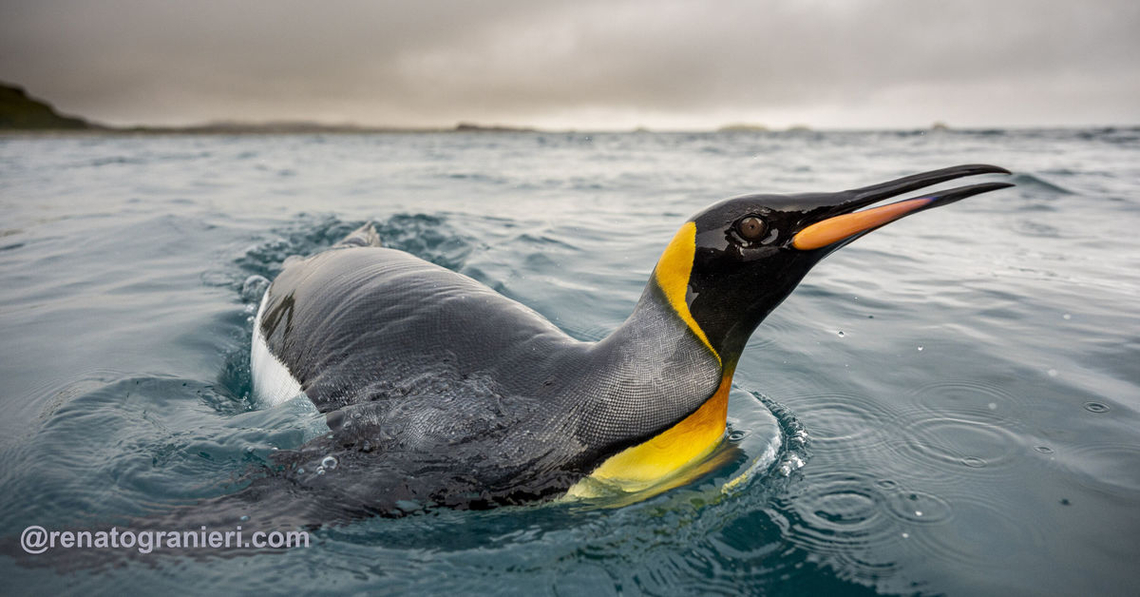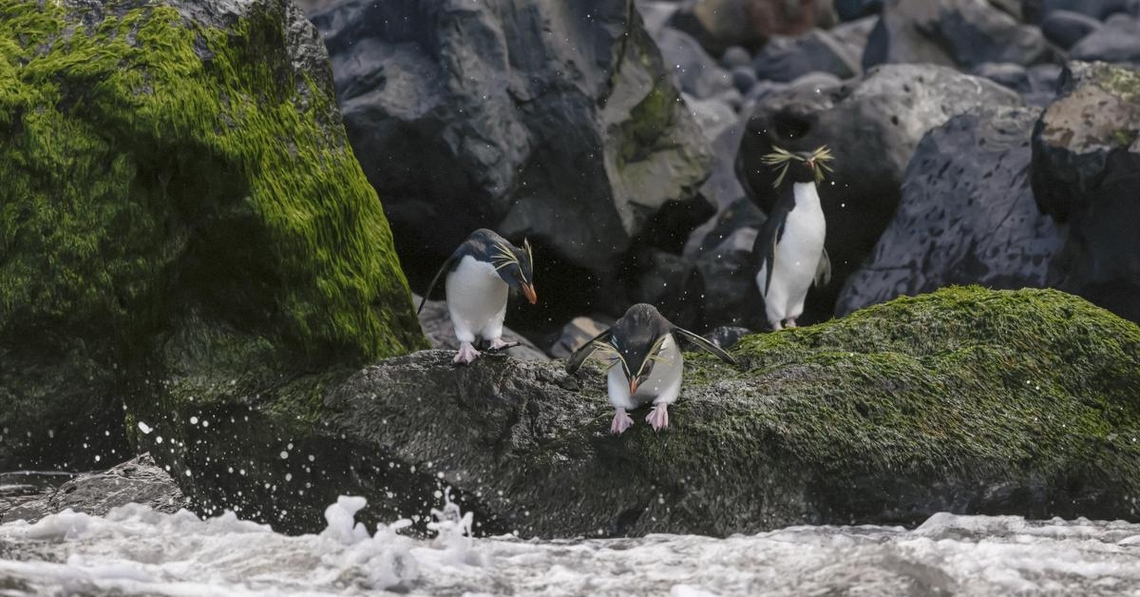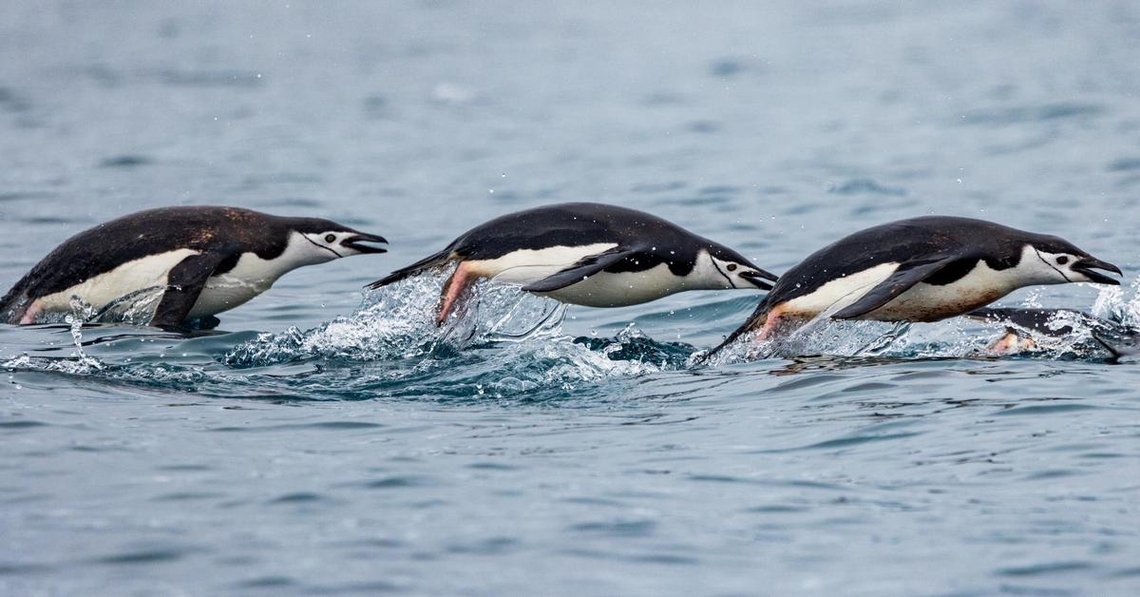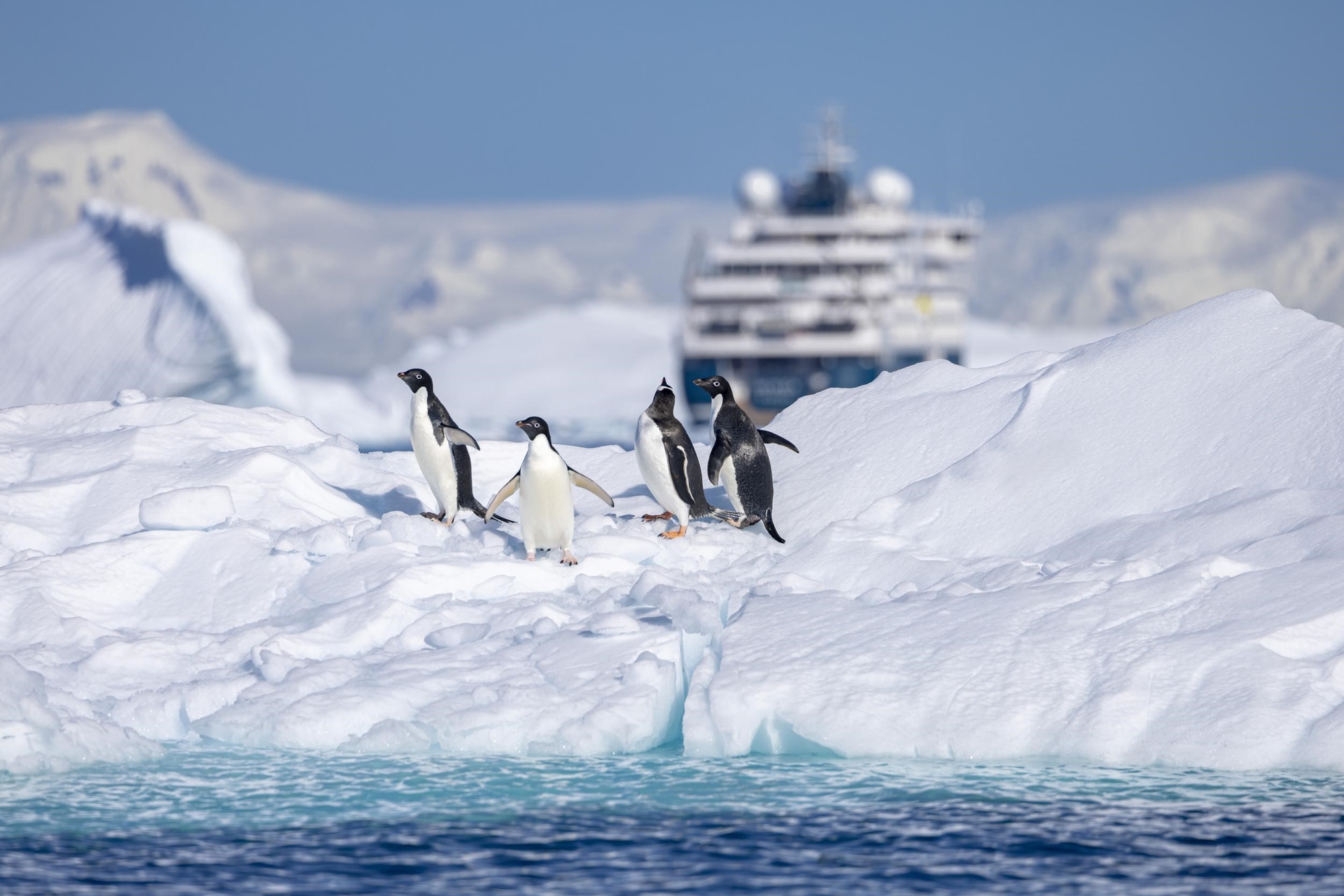
Different species
With so many types of penguins, it’s worth knowing which ones to watch out for on your Antarctic voyage. Of all the penguin species, only two – emperor and Adélie – call Antarctica their true home. However, other penguins breed or occasionally land ashore – chinstrap, gentoo and Macaroni – can be seen too on the northern tip of the Antarctic Peninsula, where conditions are milder.
These flightless birds are perfectly adapted to life in the Southern Hemisphere, especially in Antarctica’s icy waters. Each Antarctica penguin has its own unique characteristics, habitats, and behaviors. Here’s an overview of the penguins you might encounter on your Antarctic cruise.
Adélie penguin
Adélie penguins are a smaller species found throughout Antarctica. These hardy birds are known for their playful, curious nature. Thousands of Adélies gather on the rocky Antarctic shoreline around September and October to breed, with their eggs hatching in December. Watch out for the Adélie penguin’s black head and distinctive white eye ring.
Chinstrap penguin
The most abundant penguin in the Antarctic, chinstrap penguins are named after the thin black band that runs under their chin, resembling a chinstrap. These birds inhabit various Antarctic and sub-Antarctic islands, where they gather in massive breeding colonies.
Gentoo penguin
Gentoos are agile and fast-moving. They are the fastest swimmers among penguins, reaching speeds up to 22 mph. Recognizable by their bright red-orange beaks, white-feather caps, and peach-colored feet, gentoo penguins stand out against their Antarctic habitat. Often seen on the Antarctic Peninsula, gentoos prefer ice-free areas, including coastal plains, sheltered valleys, and cliffs.
Macaroni penguin
Named after their distinctive yellow plume feathers, Macaroni penguins are the largest of the crested penguin breeds. With their yellow crest flowing back from the center of the forehead, heavy orange bill, pink feet and red eyes, and distinctive hopping, these penguins are easily identifiable. Macaroni penguins breed on sub-Antarctic islands, such as South Georgia.

Emperor penguin
The largest penguin species, the majestic emperor penguin stands up to 45 inches in height, and is known for its impressive size and striking appearance. These penguins spend their entire lives in Antarctica, and can be found waddling about on the Antarctic sea ice or swimming in the icy waters there. Sightings of these birds are very rare, but it's still worth looking out for their black and white penguin plumage with yellow ear patches.
Best places to see penguins
While we can’t guarantee you’ll see penguins on your cruise with Swan Hellenic – as nature always has its own plans – we’ll make sure you have the best chances of encountering these fascinating creatures by taking you to popular penguin destinations. For instance, the northernmost part of the continent, the Antarctic Peninsula, offers excellent opportunities to see a variety of penguins, including gentoo, Adélies, and chinstraps. And the sub-Antarctic island of South Georgia is home to large colonies of penguins, including Macaronis, gentoos, rockhoppers and king penguins. In the Falklands you may see Magellanic, gentoo, and rockhopper penguins.
Seeing emperor penguins can be a bit trickier, but it’s not impossible. Emperors like extremely cold conditions, so – even though it’s seriously cold there – the Antarctic Peninsula isn’t chilly enough for them. This is because they prefer to live their whole lives without setting foot on solid ground. Emperor penguins live entirely on the sea ice, incubating their eggs on their feet through the freezing Antarctic winter. So a Swan Hellenic voyage that visits the Weddell Sea will give you the best chance to see these incredible birds.
Did you know?
Most people agree that penguins are as captivating as they are cute. They can be a bit wobbly on land, but these torpedo-shaped, tuxedo-wearing birds couldn’t be more graceful when they're in the water. It’s no wonder seeing them is a highlight of any Antarctic cruise.
Think you know all about penguins? We’ve rounded up some facts about these enigmatic flightless birds for you…
- The black and white penguin colorings help camouflage them in the water. Their black back blends in with the dark ocean water from above, protecting them from overhead predators, and from below a penguin's white belly looks similar to the sunlit surface of the ocean, which protects them from leopard seals.
- These birds are essentially flightless, with their wings functioning more like flippers in the water.
- On land, a group of penguins is called a waddle. In the water, a group is referred to as a raft.
- Penguins are accomplished swimmers and can dive 20 meters down into the water as they search for food. Emperor penguins are the deepest divers, plunging to depths of over 500m and staying underwater for around 30 minutes.
- Penguins have adapted to survive in the harsh Antarctic environment, developing a thick layer of blubber and waterproof feathers.
- Penguins are highly social creatures, living in large colonies, which can number in the millions.
- Devoted parents, penguins share the responsibility of incubating their eggs, and caring for their chicks.

Tips for Penguin Sightings on a Cruise
- Be sure to dress appropriately. Antarctica is extremely cold, so it's essential to wear warm clothing. Wearing layers will help trap heat, and waterproof gloves will keep your hands warm. Your complimentary Swan Hellenic Expedition parka will be sure to keep you cosy and dry too!
- Always follow the guidelines set by your Expedition Leader, to ensure you and the wildlife you encounter stay safe.
- Bring binoculars. They will help you observe these fascinating birds from afar, without disturbing them.
- Penguins can be curious, but avoid getting too close, and use a zoom lens if you’re taking photos.
- Stay patient! Sometimes, wildlife can be shy, so it may take some time to spot what you’re looking for.
Frequently Asked Questions
Are penguins birds?
Yes, penguins are birds. There are different kinds of penguins, but collectively they’re a group of flightless birds that have adapted to life in the water.
Are penguins mammals?
No, penguins are not mammals. They are birds, characterized by their feathers, beaks, and laying eggs.
Do penguins have feathers?
Yes, penguins have feathers. Their feathers are very dense and waterproof, providing insulation in cold environments to help them survive.
How long do penguins live for?
The lifespan of penguins varies depending on the species. Emperor penguins can live up to 20 years in the wild. Other species, such as the little blue penguin, which is the world’s smallest penguin, live for around seven years.
Are penguins going extinct?
While some penguin species are threatened or endangered due to climate change, pollution, and habitat loss, these birds are not currently at risk of extinction. However, it’s thought conservation efforts are essential to protect their populations.
